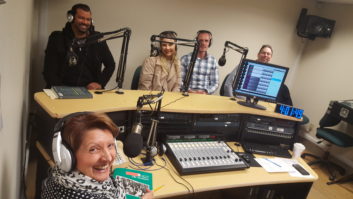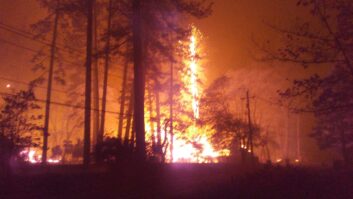I have a certain fondness in my heart for AM radio. I suspect this is true for many broadcasting veterans of my, shall we say, length of service in the human race.
When I got my first “ham” radio license at the age of 11, it was because I really wanted to be a “radio guy.” New operators like me were limited to tapping out messages in Morse Code. All of us longed for the day when we could flip the plate switch on a Heathkit DX-40 and talk into an actual microphone.

iStockphoto/Jason Gemnich My voice! Blasting out of my attic ham shack at the speed of light! Circling the globe!
(Or not, since the “blast” from the venerable Heath was really more of a dribble, at around 40 watts or so, and then only if you would scream into the mic. I mastered the technique, though, and could reliably get a 40 watt light bulb tied to the output to throw out a respectable number of lumens when I yelled “Test!-ing …Test!!-ing …TEST!!!-ING.” My neighbors, who just knew me as the pest who interfered with their TV reception, must have wondered what, exactly, I was testing all the time.)
It was AM radio, and I loved it.
Warm glow
Even before I could transmit, I was an avid receiver and, as they called it in those days, AM band “DXer.”
DX is telegraphese for “distance,” and I was right there with my dad’s old Zenith Model 7 console radio sweeping my way across the AM band, looking for the station no one else could hear.
Dad had bought an RCA 12-inch black-and-white television set that had a cabinet the size of our bathroom; there was simply no way both it and the Zenith could coexist with his easy chair in our cramped living room. He would have been reclining on the back porch watching TV with a pair of binoculars trained on the screen like an artillery spotter.
So I got the Zenith. I lugged it up to my hideout in the attic, hooked up a long-wire antenna and started listening.
I eventually knew (and dutifully logged) all of the clear-channel stations east of the Rocky Mountains including WOAI in San Antonio, the first clear-channel station to become a Clear Channel station.
The Zenith had a wonderful “magic eye” tuning tube that glowed green; the stronger the signal, the greener the little shining tube glowed. The radio itself emitted a very satisfying 120 Hz hum when it was working properly, and filled the heater-less attic with a glow and warmth that I still remember … squirreled away up there on a cold night, while the Zenith hummed and toasted along, listening to stations in cities and towns that I got to visit through AM radio.
Only game in town
In the 1960s I got a car, and then a girlfriend, and so that was the end of the Zenith. I no longer wanted to warm up to a radio, if you know what I mean.
The Zenith was retired once again and I began tuning around on the Delco AM radio in my ’56 Chevy.
Now, car radios of the day were not all that married to the idea of “high fidelity,” so the car designers stuck the speaker wherever it would fit. In the Chevy, that was in the top-center of the dashboard.
Since the dashboard was also the perfect milkshake and French fry table, all manner of odds and ends got spilled and dumped up there. Coins, paperclips, toothpicks, milkshake straws, the occasional petrified French fry — all of it ended up on the dashboard, where it of course eventually bounced down through the speaker grate onto the speaker cone itself.
The sun also baked the paper cone into the rough equivalent of ancient parchment, so what with that and the vibrating French fries and coin toss, the sound was pretty awful.
For a year or so — until I finally crawled up underneath the dash and replaced the speaker — I thought the primary instrument of most rock groups was the kazoo.
AM radio in the ’60s was really the only game in town. There were plenty of stations to choose from, both locally and, given the way AM propagates at night, across the nation.
It was against my personal coolness code to cruise around in the Chevy before 9 p.m., but that meshed perfectly with the physics of AM “skip.”
We had some great AM rock stations in St. Louis, but I preferred the bigger game that came out after dark, and so left all but one of my pushbuttons set to out-of-town stations. WABC was the gold standard; WLS and WCFL were favorites. (No one ever said the “W” except me, since I aspired to be Larry Lujack and spent endless hours saying “Double-U … L …. S!” in my best radio voice.)
KOMA in Oklahoma City was good; Bill Clinton and I probably were listening to “The Mighty Ten-Ninety, K-Double-A Y”, in Little Rock at the same time (though I’ll bet he did better in the back seat of his car than I did in mine).
In 1965, the new car warranty expired on my parents 1962 Ford Falcon. They decided that if we were going to take that long-anticipated “family vacation,” it had better be before the planned obsolescence cycle kicked in the following year and the car collapsed into a pile of steel framed by four tires.
That car had a Philco AM radio, the first car radio I ever heard that did not have a vibrator in it.
Set aside the vibrator’s later, uh, consumer uses. Car radios of the ’40s and ’50s used an altogether different device. It was a little metal can containing a vibrating contactor that turned DC battery voltage into AC, which could then be stepped up to high voltage, turned back into DC and finally, used to power the tubes.
Complicated, yes, but absolutely vital when you really, really needed an Otis Redding moment after sharing that chocolate milkshake on a Friday night date.
In any event, back in the Falcon, we chugged across the continental divide, vibratorless, while I listened to KCMO in Kansas City, KOB in Denver, KSL in Salt Lake and finally, the Mecca of AM radio (outside of New York City, at least): Los Angeles.
Oh, man. Robert W. Morgan (“GOOOOOOOD Morgan, Los Angeles! … It’s Robert W” — (he, of course pronounced it “double-U”) — “in the Morgen!!!”) The “Real” Don Steele (was there an imposter? A “fake” Don Steele?). KRLA. KHJ. KFI. More 50,000-watt screamers than even I could keep track of.
Rediscovery
Along about this time, back in St. Louis, the local NBC television and radio affiliate put on a “stereo” broadcast demonstration. FM was, of course, on the air by then (playing, oh-so-soft mortuary music, which was an order of magnitude less descript and more somber than elevator music), but it was largely broadcast in “mono.”
So to introduce the unwashed masses (those of us who had never been to a mortuary and only rarely traveled in elevators) to stereo music, they broadcast one channel on the TV station and one on KSD(AM) radio. That demonstration, with audio carefully chosen to maximize the stereo effect (“And now ladies and gentlemen … a jet airliner will seem to fly right through your living room!”), was a bit goofy; but still, for me, it marked the real “Day the Music Died” on AM radio.
FM stereo came soon after and killed the top 40 AM station; slowly, I, along with most of the rest of the audience, left AM behind for the full-fidelity fields of FM.
During the ’70s and ’80s, I never even bothered to program the AM buttons on my car radio. It was all music, all the time, and I began to think of AM radio in Newton Minow’s terms: a “vast wasteland.”
Then in 1989, I had the opportunity to drive across country in a company vehicle.
Like a lot of fleet cars in those days, this one was stripped of anything non-essential and so had only an AM radio. Well, yikes. Two days on the road with “nothing” to listen to.
Except that it was on that trip that I rediscovered AM radio, to my complete delight. Every town, large, small and in between, has an AM radio station. Unlike a lot of small-market FM stations that are plugged into satellite dishes for 22 out of 24 hours, many of these are run by actual humans.
The result for me was a running, town-by-town local and regional commentary as I drove right across America.
Driving in the deep South, it was hard to find a town that didn’t have a southern gospel station preaching an Elmer Gantry sermon. In the Midwest, I learned an awful lot about pork bellies and wheat futures. Into Oklahoma and Texas, it was country (and I mean Patsy Cline, pickin’ and strummin’ country), giving way to TexMex and Tejano about 100 miles south of Dallas.
I heard more accordion music in Texas than Lawrence Welk ever thought of playing. And of course, every couple of hundred miles, a blowtorch: KMOX, WWL, KRLD, WBAP, WOAI.
Major-market coverage and events, and in between the big guys, town “doin’s”; high school sports, little tidbits of folks’ lives.
All of it comes through the local AM radio station. It was like driving back in time, and I loved every minute of it.
I ended up owning an AM radio station in Texas. I have divided the net profit by the number of hours I work at this endeavor each month, and if I was schizophrenic, I would sue myself for underpayment of the federal minimum wage. It is not the easiest game in town, by a long shot; but for all that, it is a lot of fun.
And I do sometimes wonder, in the middle of a long night at the transmitter site trying to squeeze that last watt up into the antenna, if there is a kid out there somewhere, not yet jaded by the Internet and iPods, cellphones and texting; who, with the help of an old AM radio, has just stopped by for a visit.
The author is owner of KSIX(AM) in Corpus Christi, Texas and a partner in KRBK(DT), Springfield, Mo. Reach him at[email protected]. Comment on this or any article. Write to[email protected].












